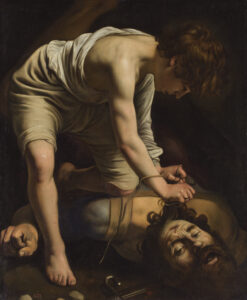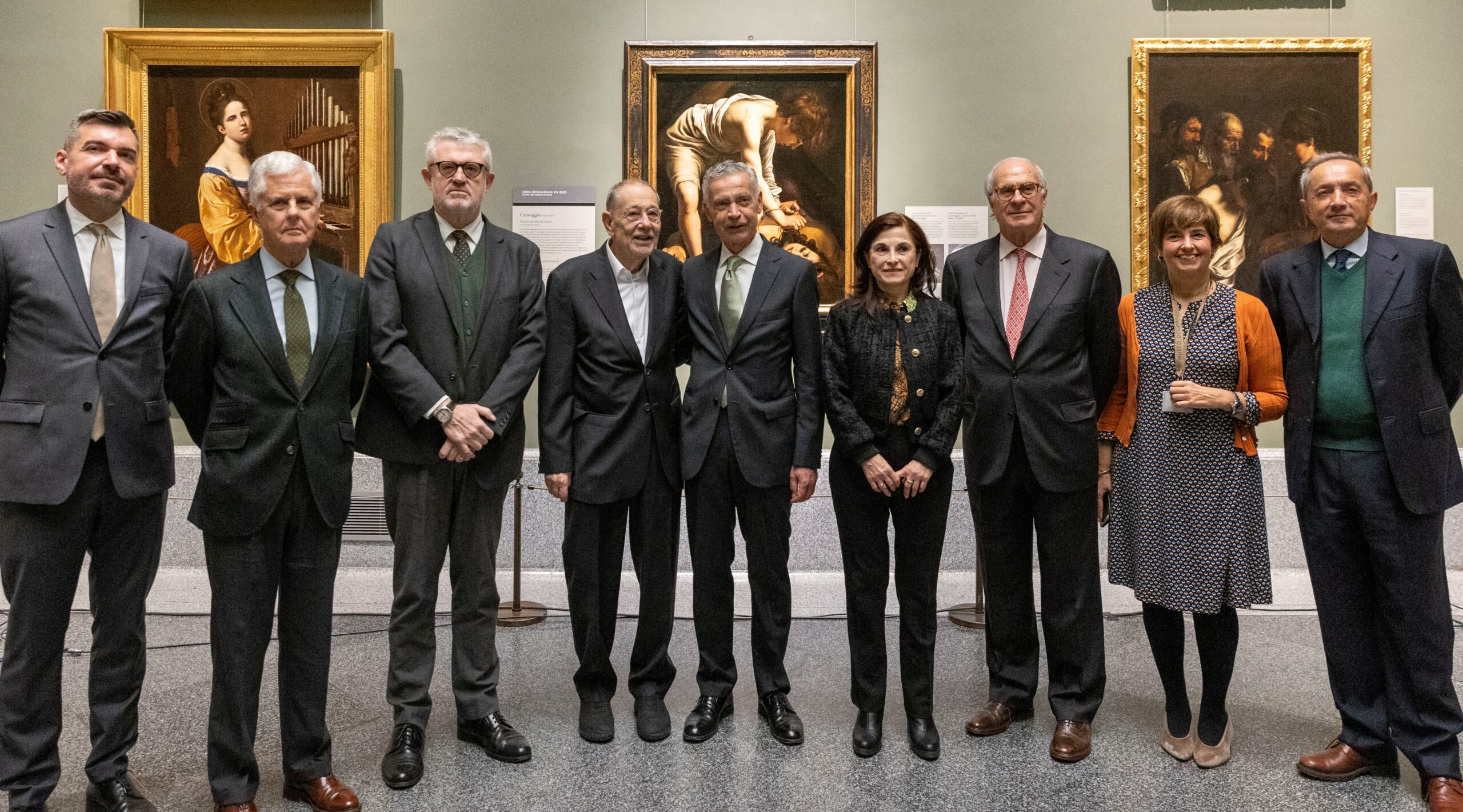The Prado Museum exhibits its magnificent ‘Caravaggio’ after a restoration sponsored by Fundación Iberdrola España
- With the collaboration of the Fundación Iberdrola España, a member of the Museo del Prado’s Restoration Program, the work has undergone a process of removing oxidized and opaque varnishes on the surface to restore the painting’s chromaticism and contrasts
- This intervention, carried out by Almudena Sánchez, restorer of the Museo Nacional del Prado, has made it possible to recover the original values of the work and has revealed elements of the composition hidden under the opacity of the varnish, such as the clear light surrounding the head of the young David or the foreshortened body of Goliath
The Museo Nacional del Prado and Fundación Iberdrola España present today in room 7A of the Villanueva building the work David defeating Goliath by Caravaggio after having undergone a thorough restoration within the framework of the program sponsored by Fundación Iberdrola España.
The main objective of this restoration has been to restore to the work the original image conceived by the master of chiaroscuro, Michelangelo Merisi “il Caravaggio”, which over time had been lost under the effect of layers of dirt and oxidized varnishes. The opacity of these old varnishes suppressed space and depth in the composition and made it difficult to perceive the dimensions of the place where David and Goliath are located, since in the scene as a whole, only the areas strongly illuminated by the spotlight could be distinguished in both figures.
In the words of Almudena Sánchez, responsible for the restoration of this work: “This restoration shows us a new Caravaggio, providing us with a previously unknown image of the painting, the authentic image of this great masterpiece that, after so long in the shadows, recovers the light with which it was conceived”.
The technical studies of infrared reflectography and radiography have allowed us to know the state of conservation of the painting and the creative process of the artist.
Thanks to its excellent state of conservation, it is possible to appreciate the glazes and halftones, subtle and fragile layers that contain great information about the technique of the brilliant artist.
As for the creative process, there are notable changes in the composition, such as the astonishing face of Goliath, still alive, with a dramatic expression, his eyes wide open and his mouth agape in a gesture of terror. One of the most striking elements was the foreshortened body of Goliath, specifically his buttocks in the right area of the painting, continuing with his leg, which appears raised behind David towards the upper part of the painting, an image that shows the defeated body of Goliath after being hit by the young shepherd’s sling. The space around Goliath’s head and his chest resting on the ground is also recovered, as well as the arm that passes behind David’s leg coming forward with the fist of his hand.

Another unsuspected element that has appeared with the cleaning is the clear light that surrounds the head of the young man, a light that is cut diagonally by a dark shadow that gives the dimension of the space in the background. The cleaning has also resulted in the recovery of the successive planes of the composition and of the air that circulates David’s figure, which was previously non-existent. In addition, the complexity of the composition can be appreciated by the very small space in which Caravaggio has placed the two characters, in a rectangular space as if it were a deep box.
Thanks to the radiographic study it has been possible to notice the existence of two very specific damages that must have occurred accidentally. The most important one is on the sleeve of David’s shirt and the other on his knee continuing along Goliath’s shoulder. Both had very old restorations that invaded the original painting, recovered in the current restoration with the elimination of the repainting. The lack of color in these two areas was integrated into the pictorial surface through the process of chromatic reintegration.
Fundación Iberdrola España, Protector Member of the Prado Museum
The Fundación Iberdrola España develops one of its main lines of activity around the care and maintenance of the cultural and artistic riches of our country.
Fundación Iberdrola España acquired the status of “Protector” of the Museo Nacional del Prado in 2010, through its support for the conservation and restoration programs of the art gallery, as well as the development of 4 annual scholarships for young restorers. Thanks to this collaboration, it has been possible to carry out interventions that have given back to great works of the Prado collection the luminosity and depth with which they were conceived, such as Dürer’s Adam and Eve, The Wine of the Feast of St. Martin and The Triumph of Death by Pieter Bruegel “the Elder”, La Gioconda from Leonardo’s Workshop, The Adoration of the Magi and The Temptations of St. Anthony by Bosch, The Annunciation by Fra Angelico, The Countess of Chinchón by Goya and most of the pieces from the Treasure of the Dauphin.
In addition, after joining the Extraordinary Program for the Commemoration of the Bicentennial of the Prado Museum and, specifically, the deployment of the traveling exhibition “The Prado in the Streets”, Fundación Iberdrola España has continued to develop this exhibition in different autonomous communities of Spain.
In 2019, the “Lighting del Prado” was inaugurated, a project in which the museum’s exhibition halls, both those housing the permanent collection and those containing temporary exhibitions, were equipped with a new lighting system using LED technology to replace the previous system based on halogen lamps.
Since 2011, Fundación Iberdrola España has allocated a total of 13 million euros to the Art and Culture area, which mainly focuses its resources on the Restorations Program, which supports the restoration workshops of reference museums for the conservation of their pictorial and artistic heritage; and the Lighting Program, which contemplates the design, execution and financing of artistic lighting projects in unique buildings and monuments.

